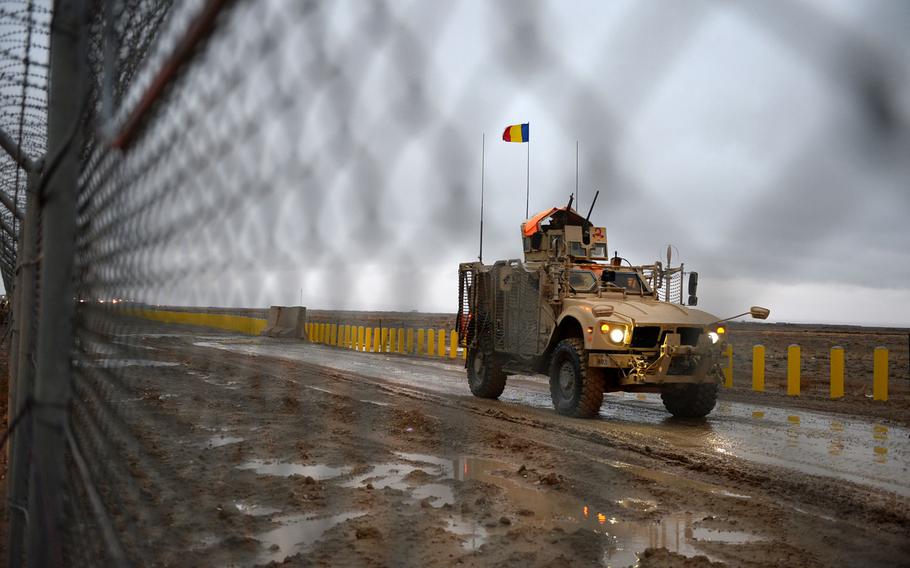
A Romanian vehicle drives just outside Kandahar Air Field, Afghanistan. Days of rain and snow have turned unpaved ground to cold mud. (Cid Standifer/Stars and Stripes)
KANDAHAR AIR FIELD, Afghanistan — A few months ago, daily temperatures spiked at 130 Fahrenheit here. But recently, soldiers slogged through freezing mud and slipped over ice on the boardwalk, while dark, low-hanging clouds made all hours of the day look like dusk.
Snow is exceedingly rare in this southern desert. For a week at the beginning of February, a handful of flurries brought operations here screeching to a halt. All the military’s high-end technology was rendered useless.
1st Lt. Russell Mixon, a Black Hawk pilot, said his crew had been grounded for a week — the first time weather had so severely clipped his wings in six months at Kandahar Air Field. At a coffee shack near the flight line, when asked how the weather was treating him, Spc. Andrew Rivas gave a hard stare and said, “Is that a joke?”
Master Sgt. Steve Fisher, one of the Air Force’s battlefield weather forecasters at Kandahar, has found himself once again the bearer of bad news.
“Weather is changing constantly, and weather is doing exactly what weather does,” he said. “So as we tell people, ‘We’re in sales, not production.’”
Fisher and fellow forecaster Staff Sgt. Rachelle Moran say their forecasts are part science and part art. They look at the copious data available, mesh together their favorite meteorological models, make their best educated guess, and watch to see if they were right.
And saying whether or not skies will be cloudy isn’t good enough. If they predict a cloud ceiling of 2,000 feet and end up with a cloud ceiling of 5,000 feet, they call their forecast “100 percent wrong,” because it means they gave commanders bad information about which operations would be possible.
Black Hawk pilot Maj. Darin Gaub with Task Force Demon knows firsthand what kinds of messes pilots can get into if the weather changes unexpectedly. He recalled trying to get home from a mission in eastern Afghanistan in 2006 that forced him to hop from ridge to ridge all over the region, looking for valleys clear enough to meander down, after the cloud cover settled on the tops of the mountains.
Snow and ice can easily take down a Black Hawk. Gaub said 150 pounds of ice can build up on the copter’s blades, and it takes only a few ounces to throw it out of balance. The blades can be heated electrically to melt ice away, but snow often comes with low visibility, a problem in itself.
Chinook pilot Maj. Eric Edward Artemis, who has similar tales of bad weather in the mountains, said nothing in training can completely prepare helicopter pilots for the Hindu Kush.
“There’s nowhere in Korea that’s anything like here. Iraq was a lot simpler,” he said. In Afghanistan, he added, “the weather is deadlier than the enemy.”
So instead of risking the Kandahar snows, Artemis and Gaub were grounded that week, sorting out which delayed missions would take priority once the clouds lifted and catching up on helicopter maintenance.
Mixon said his crew was similarly spending the ground time on maintenance and administrative tasks.
“It’s actually been a nice chance for us to catch our breath,” he said. “With the group of guys we’ve got out here, it’s hard to get bored.”
And after they cleaned the snow from the bird, he added, there was enough handy for a snowball fight.